
| Hybrid Flask List |
| Orchid Programs |
When you get the seedlings
If your seedlings have been deflasking before shipping, they have also been treated with a fungicide and beneficial microbes to improve survival. If a bit of agar is still on the roots, you can either wash it off or just leave it. If they are still in flask, you can remove the seedlings by carefully freeing the roots from the agar if the medium is still intact. If the plants are jumbled, rinse the agar off of the plants with tepid water and be sure that no agar remains in the crown of the plant.
Once the plants are out of the agar, I sort them out roughly by size on a clean paper towel or other paper. I try to pot them up with similar sizes. It is normal to have a variety of sizes in a flask even if they were all the same size when they went in. There may be some that are very, very small or little balls of tiny plantlets and the likelihood of these surviving is small. Some people try to save them and some people don't.
Humidity
The seedlings have been growing with 100% humidity and constantly available nutrients in the media. To put them out in a dry environment or less than ideal conditions during the first week or two can be a shock. Even in my humid greenhouse I still prepare the seedlings to adjust them to their new conditions over the space of a week or two. The best way that I have found once they are potted or mount is to cover them in a plastic dome or tent of some sort. These can be made from things that are readily available at home and there are variety that can be purchased that will work well. You want to keep the humidity high so that they don't lose so much water through the leaves that the roots can't take up enough. If your seedlings are short, the disposable aluminum cake pans with a plastic lids that you find in the grocery store will work fine. A hydroponic store is a very good source of sturdy trays with plastic domes to fit. I lift the lid of the tray to let in fresh air every day or two during the first week and more often after that. I also keep the seedlings in a bit lower light until they have had a chance to adjust. Water them in well after potting.
Potting vs mounting
I prefer to pot the seedlings into compots (community pots) so that the seedlings are fairly close together. Even for plants that I will later mount, this has given me the best growth. I used to mount the larger plants from a flask and put the smaller plants into a compot. With some experience I have noticed that the smaller plants in the compot were sometimes as large or larger than the large plants that I had mounted. But this is personal preference and what works for me may not work in other situations. If the seedlings are large enough they can be planted into individual containers of appropriate size.
Media
Most frequently I use a fine bark mix or good quality sphagnum moss as the potting medium for seedlings. I don't grow my plants very often in sphagnum moss, but I do find it good for establishing seedlings. If the seedlings are ones that like to dry between waterings you could use a medium to medium-small bark. You may also use a slightly smaller grade of what you would use for a mature plant.
Containers for compots
I try to use proportionately shorter containers for the seedling compots than I would for an adult plant. Some people choose to fill the extra space at the bottom with inorganics such as peanuts, LECA or rock. I prefer to shorten the container. Even if I'm planting them in a 4” diameter pot or net pot, I will cut the container down so it's about 2 to 3” tall depending on the plants. This seems to allow for more even drying. If you want to pot in small plugs or sectioned 6 packs, most hydroponic stores carry a range of things that will work.
Seasonal variation
The seedlings seem to know what time of year it is even under lights. Many of the plants that I have flasked that have deciduous leaves will drop them or have them brown off during the winter. They aren't dead and will start new growths on their schedule. When taking out these plants it is best to give them a softer version of the dry rest they will experience as mature plants. As they begin to grow in the spring, watering is increased. But in the winter, don't let the humidity drop too much and do mist or water them occasionally. This does not apply to some terrestrials that still need a defintedry rest.
Fertilizer and treatments
I water seedlings with dilute fertilizer (about 1/5 to 1/4 teaspoon per gallon) as soon as they are potted or mounted. They have had constant moisture and nutrition in the flask and see no reason to withhold it once they are out. I have also become a firm believer in using beneficial microbes to increase the chance of healthy root growth. There will be a mind-boggling number of products on line and at hydroponic stores containing a variety of microbes and other ingredients. I am currently using Bushdoctor Microbe Brew which is easily available on the internet and not very expensive. I now also use a fungicide in combination with the microbes and have found the combination has cut down my losses significantly. I treat the seedlings with a fungicide along with the microbes. Exel Lg systemic from the hydroponic industry has worked well. I use this combination as a drench once the seedlings are potted or mounted. If your seedlings came deflasked, they have already been treated.
Good Luck!
Here are some pictures of deflasking Polystachya fallax.
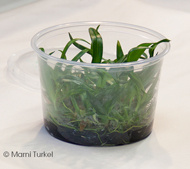
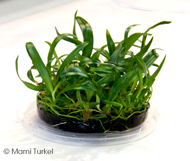
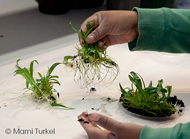
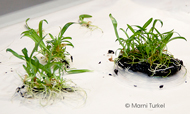
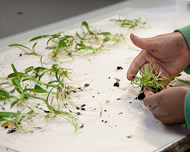
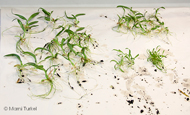
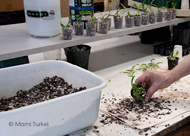
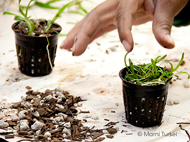
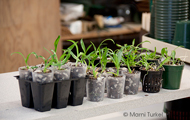
Mostly Species / Orchids and Flasks | Santa Rosa, CA 95407
© Marni Turkel 2003-2022 All rights reserved